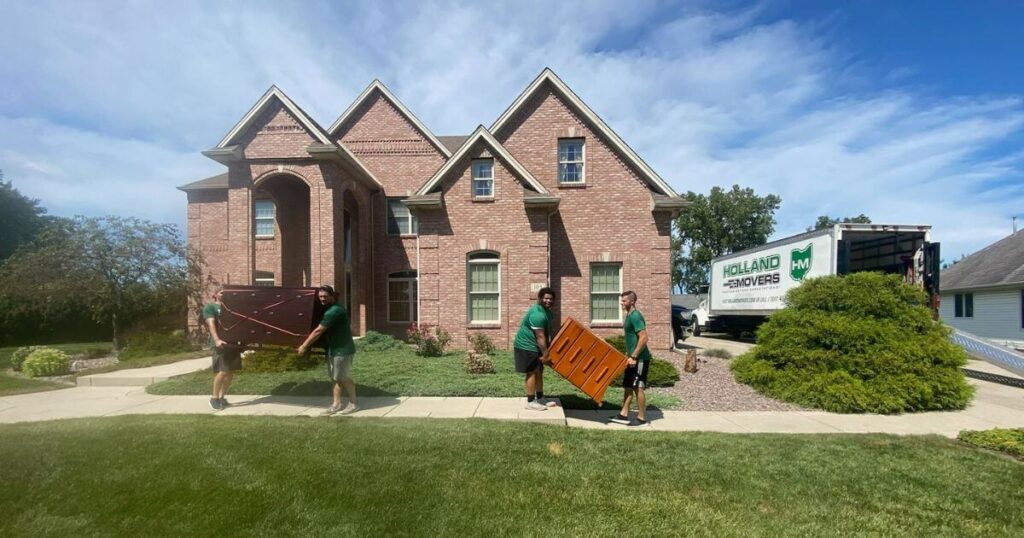
Moving with kids doesn’t have to be a hard task. Thoughtful planning, such as explaining the move to your kids in language they understand and including them where possible, can effectively prepare them and reduce stress. Additionally, strategic approaches like packing quick-access bags of necessities and familiar items help maintain normalcy amidst the chaos. But remember, patience is key during a move; children may need extra reassurance and understanding during this time of change. It all starts with preparing well before you make your move. And when it comes to local moving, trust Holland Movers to handle your relocation with care and efficiency.
When moving with kids, it’s crucial to maintain open communication and involve them in the process. Consider enlisting their help in packing their belongings and allow them to have a say in decorating their new room to foster a sense of ownership and familiarity. Additionally, plan visits to the new town and create opportunities for them to connect with potential friends or social groups to ease the transition.
Moving with Kids: Top Tips for a Smooth Family Relocation
Moving to a new home can be a significant change for everyone, especially for kids. It’s crucial to consider their emotions during this transition period. Honesty and transparency are key when talking to children about the move. Keep them informed and involved in the process right from the start. Let them know why you’re moving and reassure them that they will still be able to keep in touch with old friends and make new ones in the new place.
Enlist your children as part of the team by giving them a say in choosing a new home, packing their belongings, and decorating their new room. Their involvement will give them a sense of control and help them feel more comfortable with the upcoming changes.
In addition to involving them in the decision-making process, it’s also beneficial to take your kids on a recon trip to the new town to familiarize them with the area. This can help alleviate some of their anxieties about the unknown and get them excited about their future environment.
Connecting with other parents through social networks or local parents’ groups can also provide support for both you and your kids. It’s an opportunity to share experiences, seek advice, make potential friendships for your kids, and gain valuable insights about the new community.
Considering these tips when relocating with children can help ease anxieties and create an environment where they feel secure and involved in the exciting process of moving to a new home.
By following these steps, you can lay the foundation for a successful relocation experience. Now, let’s delve into the essential preparations needed when moving with children in tow.
Pre-Move Preparations with Children
One of the initial steps to ensure a smooth relocation with kids is to gather the family for an open discussion about the move. Children often have questions and concerns about leaving their current home, friends, and school. It’s essential to address these worries and involve them in the decision-making process as much as possible. By including them in discussions about the new home, neighborhood, and schools, you can help alleviate their fears and make them feel valued.
Taking the time to listen to your children’s feelings and worries about the move can make a big difference. It shows them that their opinions matter and helps build trust during this transition period. Encouraging open dialogue can also uncover any hidden worries or misconceptions that may be troubling your kids. For instance, consider hosting a “family meeting” where everyone can share their thoughts and feelings about the move. This can create a safe space for open communication and allow children to express any concerns they may have. Additionally, involving children in decisions such as choosing a new home or discussing potential activities in the new area can foster excitement and anticipation rather than anxiety.
Exploring the New Neighborhood
Once the decision to relocate has been made, if possible, take the opportunity to visit the new neighborhood with your children. Exploring nearby parks, schools, and recreational areas can help familiarize them with the new surroundings and create a sense of excitement about the move. This early introduction can ease any apprehension they may have about starting anew in an unfamiliar environment.
Allowing children to explore their new neighborhood ahead of time provides them with visual context and helps them mentally prepare for the change. It also offers an opportunity for kids to envision themselves in their new surroundings, which can make the adjustment period less daunting. Consider planning fun outings during these visits, such as trips to local parks or visits to nearby attractions that may interest your children. Engaging in activities that showcase the positive aspects of the new neighborhood can instill positivity and enthusiasm about the upcoming move.
By actively addressing concerns, involving your children in discussions, and familiarizing them with the new area, you are setting the stage for a smoother transition. These proactive steps can help create a positive outlook for both parents and children amidst the changes that come with moving to a new home.
In helping children adjust to a relocation, it’s important to keep their well-being at the forefront of every decision. Now, let’s shift our focus to making the packing and unpacking process child-friendly.
Child-Friendly Packing and Unpacking
Moving to a new home with kids can be overwhelming, but involving them in the packing process can lessen their anxiety and make them more excited about the change. Here’s how you can make the packing and unpacking experience child-friendly.
Personalized Packing
Giving children control during a move is empowering and comforting for them. Start by allowing them to pack a small box of their favorite belongings, such as toys and games. This gives them a sense of ownership over the process and allows them to bring a piece of their old home to the new one. Encouraging them to personalize their box with stickers or drawings can also make the process more enjoyable for them.
| Personalized Packing Checklist: |
| – Let each child choose items they want to keep close during the move. |
| – Supervise younger children to ensure they pack age-appropriate items. |
| – Encourage them to decorate the box with their names and drawings. |
By involving your children in this way, you’re not only lightening your load but also helping them feel secure amid the changes. It’s a small step, but it goes a long way in making the transition smoother for everyone.
Unpacking Their Items First
Upon arrival at the new home, prioritize unpacking the children’s belongings. Create a joyful environment as they see their familiar items coming out of boxes, reassuring them that their new room will feel just like home in no time.
Unpacking Tips:
- Place their boxes in their new rooms so they feel an immediate sense of ownership.
- Encourage them to arrange their belongings and decorate their space as they like.
Remember, moving is a big change for kids, and maintaining a familiar environment around them can ease feelings of displacement, making the new house feel more like home from day one. By prioritizing your children’s belongings, you’re giving them a sense of control during a time when everything might seem out of control.
By involving your children in both the packing and unpacking processes, you not only give them ownership over their belongings but also help create a positive outlook on the move, turning their new house into a comfortable and welcoming home.
Creating Familiarity in the New Home
Moving to a new home can be overwhelming, especially for kids as they adjust to new surroundings. One way to make this process smoother is by involving them in setting up their new space. Having an active role in the setup can help them feel more connected and comfortable in their new environment.
Think about it this way: when we find ourselves in a new place, adding our personal touch can make us feel more at home. It’s no different for children. Allowing them to have a say in how their rooms are arranged provides them with a sense of ownership and control over their space, helping them to adapt more easily to the change.
Setting Up Their Space
When it comes to setting up their space, ask your children where they’d like different items placed, what color schemes they prefer, and how they’d like to decorate. By including them in these decisions, you’re giving them the opportunity to express themselves and feel like an essential part of the moving process.
By letting children choose where their furniture goes and what decorations go on the wall, it makes the new space feel more like their own and less like a strange place they’ve been moved into.
Remember: Children are susceptible to change, but allowing them to have some control over their environment can help alleviate their anxiety and ease the transition.
Apart from involving your kids in setting up their space, it’s also crucial to ensure that familiar items are prominently featured in their new rooms.

Ensuring Familiar Items Are Featured
One of the best ways to make a new space feel familiar is by incorporating items from the previous home. When you surround yourself with familiar things, it can provide a comforting sense of continuity. The same applies to children; seeing something as simple as their favorite toy or family photograph can offer them a sense of security amid change.
Familiar Items
Ensure that familiar items such as bedding, favorite toys, and family photographs are prominently displayed in their new room. This will create a comforting environment and help ease any feelings of disorientation that come with moving to a new home.
Imagine walking into a room that looks different but features all your favorite things—this is exactly what these familiar items can do for your child.
By including your kids in setting up their rooms and featuring familiar items, you’re providing them with a comforting anchor during this period of change. This effort helps them transition into the new home with a greater sense of ease and comfort.
In the midst of accommodating your children’s needs during the move, it remains equally important to establish routines that provide structure and stability post-relocation.
Routine Management after Moving
Moving to a new place can be both exciting and challenging for young children. One of the most effective ways to ease their transition is by maintaining familiar routines. Children often find comfort in predictability, so sticking to established meal times, bedtime rituals, and playtime activities can provide a sense of stability amidst all the changes. This doesn’t mean you have to rigidly adhere to the same schedule, but ensuring that key aspects of their daily routine remain consistent can go a long way in helping them adjust.
For instance, if bedtime story reading or evening walks were regular activities in your old home, try to carry that tradition over to your new space. It will help your children feel that some things haven’t changed despite the move. It’s also important to set clear boundaries and rules in the new environment, aiding children in understanding what’s expected of them in this new setting and giving them a sense of security. Moreover, involving your children in creating these routines could give them a sense of ownership and control during this period of change. By establishing predictable rhythms in their day-to-day life, you’re providing them with a sense of normalcy which is indispensable for their emotional well-being during the relocation process.
Exploring New Opportunities
Relocating to a new neighborhood is an opportunity for children to discover new hobbies and activities they might enjoy. Encouraging them to engage in different clubs, sports teams, or artistic pursuits not only provides an outlet for their energy but also helps them integrate into the community. For instance, enrolling them in local sports leagues or music classes allows them to meet new friends who share similar interests, fostering a sense of belonging in their new environment. This exploration phase enables children to adapt to their surroundings by finding common ground with others and realizing that they are not alone in this process.
Though it’s vital to encourage engagement in various activities, it’s equally important to allow children the time and space needed to adapt at their own pace, without imposing too much pressure on them. By championing exploration and offering reassurance while maintaining familiar routines, parents can significantly aid children in navigating the challenges associated with moving homes.
Now let’s shift our focus to strategies aimed at reducing relocation stress and ensuring a smooth adjustment period for both parents and children.
Reducing Relocation Stress
Moving to a new home can be an exciting yet stressful experience for children. The change in routine and environment may induce feelings of anxiety and uncertainty. As a parent, there are strategies you can employ to alleviate their stress and make the transition smoother.
Open Communication
Encouraging open communication about the move with your children is crucial. Creating a safe space where they feel comfortable expressing their feelings and concerns about the relocation is essential. Listen attentively to their worries and provide reassurance by addressing each concern with empathy and understanding to help them feel more secure amidst change.
Children may have fears related to leaving behind friends, changing schools, or adjusting to a new environment. Actively engaging in conversations about these fears validates their emotions and offers support. Encouraging them to ask questions and openly sharing information about the new home and neighborhood can also help ease their anxiety.
Engaging in Family Activities
Planning fun family outings or activities in the new area is another effective way to reduce relocation stress for children. Creating positive associations with the new location through enjoyable experiences can help them embrace the change with more enthusiasm.
Exploring local parks, museums, or recreational facilities as a family can empower children and make them feel more connected to the new community. Organizing playdates or social events with other families in the neighborhood can facilitate the development of new friendships for your children, further easing the transition. Remember that building these positive associations takes time, so be patient and allow your children to adjust at their own pace.
By implementing open communication and engaging in enjoyable family activities, you can help reduce relocation stress for your children, fostering a more positive experience during this significant transition.
Building a sense of comfort and safety during relocation is fundamental for a smooth transition for both parents and children alike. Let’s now explore practical methods to ensure comfort and safety throughout the moving process.
Ensuring Comfort and Safety During the Move
Moving can be really exciting but also a little scary for kids. It’s important to make sure they feel safe and comfortable throughout the journey.
Safe Travel Arrangements
When planning your move, prioritize the safety of your little ones. If you’re using professional movers, choose a reputable company known for prioritizing safety and efficiency. Look for companies with a strong track record of securing belongings and ensuring client safety during the relocation process. Additionally, read reviews and seek recommendations from friends or family who have used moving services with children before.
You’ll want to ensure that the moving process is not only efficient but also safe and secure for your children. This means selecting a moving company that takes extra care in handling fragile items, especially if you have young children who require close supervision during the move.
In addition to considering the safety measures taken by professional movers, it’s important to prepare your own vehicle for the journey if you plan on driving to your new home. If driving for an extended period of time, ensure that car seats are properly installed and provide a comfortable and safe seating arrangement for your children. Regular breaks during long drives will also contribute to the safety and well-being of everyone in the vehicle, especially young travelers.
Comfort Items
Children often find familiarity comforting, especially in new or unfamiliar environments. To help ease any anxiety or discomfort experienced during the move, prepare a travel bag with essential comfort items for the kids. This can include snacks, favorite toys, blankets, and entertainment such as books or portable electronic devices.
Having these items readily available during travel can provide a sense of security and normalcy for your children as they navigate through the changes associated with relocating to a new home.
For example, consider involving your kids in selecting some of these comfort items prior to the move. Allowing them to choose a few toys or books that will travel with them can give them a sense of control over their immediate surroundings while fostering excitement about the journey ahead.
By prioritizing safety in travel arrangements and providing familiar comforts during the move, you can help make the transition experience more positive and reassuring for your children. Creating an environment where they feel secure and at ease will greatly contribute to a smoother relocation process for the whole family.
For personalized guidance on managing a smooth family relocation, contact us at Holland Movers. Call Holland Movers At (419) 452-2017.












